Transit Of Venus
On June the 8th, in the year 2004, a rare astronomical event will occur that has probably not been seen by anyone alive on the planet Earth today. It last occurred in the year 1882 - a transit of the planet Venus. Once of great interest to science, it now has an interest more historical, and a curiosity value that any rare event draws around itself. Many amateur and professional astronomers, as well as many 'just interested people' will travel to diverse, and hopefully cloud free, parts of the world to view this spectacle.
For those who miss this event, it will be repeated eight years later, on June 6 in the year 2012.
In Australia, most people will be able to view at least part of both transits, if the weather permits. And it is Australians for which this event has the greatest historical significance, more so than for any other people on the planet.
WHAT IS A TRANSIT OF VENUS?
A transit of Venus is simply the passage of the planet Venus across the face of the Sun as seen from the Earth. Only two planets can ever be seen transiting the face of the Sun. These are Mercury and Venus, the only two planets that have orbits closer to the Sun than the orbit of the Earth. Planets, such as Mars, Jupiter, Saturn, Uranus, Neptune and Pluto all have orbits beyond that of the Earth, and so can never come between the Earth and the Sun.
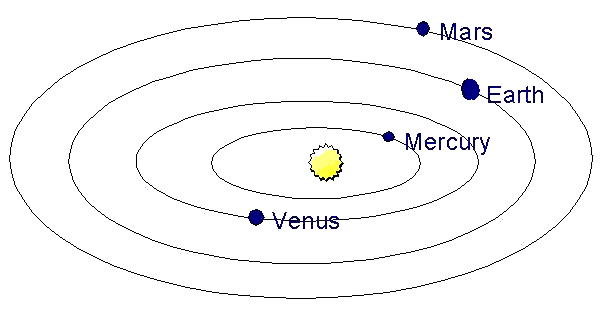
The table below contains some information about the three closest planets to the Sun (including the Earth). This can be useful in understanding why and when planetary transits occur. The first column lists the planet name, the second its diameter in kilometres. We can see that Venus is about the same size as the earth, while Mercury is substantially smaller. The third column lists the time in (Earth) days that it takes for the planet to complete one orbit around the Sun - this is the length of the planet's year. The fourth column is the average distance of the planet from the Sun.
The last two columns are a little more difficult to understand, but in them lies the secret of the scarcity of planetary transits. The orbital inclination is the tilt of the planet's orbit with respect to the Earth's orbit, and the eccentricity measures the 'circularity' of the orbit. The closer this number is to zero, the more the orbit approaches a perfect circle.
| PLANET NAME | Diameter (in km) |
Revolution Period | Distance from Sun-km |
Orbital inclination | Orbital eccentricity |
| Mercury | 4,900 | 88 days | 58 million | 7.0 deg | 0.206 |
| Venus | 12,100 | 225 days | 108 million | 3.4 deg | 0.007 |
| Earth | 12,800 | 365 days | 150 million | 0.0 deg | 0.017 |
WHEN WILL THE TRANSITS OCCUR?
In the 21st century, the first transit of Venus will occur on June 8, 2004. The start and end times of the transit depend by several minutes on your position on the Earth's surface, but on average the start time will be around 05:13 UT and the end time will be near 11:26 UT, where UT stands for Universal Time. This is the time at zero degrees longitude (and was formerly known as Greenwich Mean Time).
The second transit will occur on June 5/6, 2012.
There are four points in time that astronomers refer to when describing the progress of the transit. First contact is when the limb (edge) of Venus just touches the limb of the Sun. Second contact is when all the disc of Venus first sits just inside the solar disc. Third and fourth contacts are similar positions when Venus is egressing from the Sun. That is, at third contact, the whole disc of Venus just lies inside the solar disc prior to passing out of the disc. And lastly, fourth contact is when the limbs of Venus and the Sun are just touching prior to Venus breaking away out into the blackness of space. These four contact points are illustrated in the diagram below.
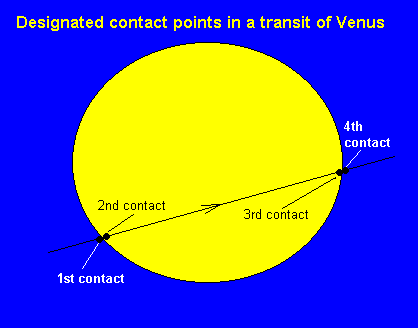
The following table gives the times (both in Universal Time and local time) for the relevant contact points for some of Australia's capital cities. A dash indicates that the point is not visible from that location. For instance, sunset occurs before third and fourth contacts for all of Australia in the 2004 transit.
THE 2004 TRANSIT
| CITY | First Contact | Second Contact | Sunset |
| NAME | UT / LT | UT / LT | Local Time |
| Adelaide | 05:08 / 14:38 | 05:27 / 14:57 | 17:11 |
| Brisbane | 05:07 / 15:07 | 05:26 / 15:26 | 17:00 |
| Melbourne | 05:08 / 15:08 | 05:26 / 15:26 | 17:08 |
| Sydney | 05:07 / 15:07 | 05:26 / 15:26 | 16:53 |
| Perth | 05:10 / 13:10 | 05:28 / 13:28 | 17:19 |
The complete transit will not be visible from every part of the world. Those favoured to see the whole 6 plus hours of the phenomenon include all of Europe, most of Asia, and a large part of (eastern) Africa. In Australia, we will not see the end of the event, as the Sun will set on our land before that occurs. Unfortunately, none of the transit will be visible to people in the western half of the USA.
People living on North West Cape, Western Australia will be able to view the transit for the longest period of time, and those in southern Tasmania for the shortest period of time of all inhabitants of Australia. Unfortunately, New Zealanders will mostly be in the dark, as the transit occurs just on sunset for those in Auckland, and after sunset for those in the South Island.
And we must remember of course, that visibility is not only dependent upon where we live. The weather will also play a large part in who gets to watch the event.
THE 2012 TRANSIT
| CITY NAME | 1st Contact UT / LT |
2nd Contact UT / LT | 3rd Contact UT / LT |
4th Contact UT / LT |
| Adelaide | 22:16 / 07:46 | 22:34 / 08:04 | 04:27 / 13:57 | 04:45 / 14:15 |
| Brisbane | 22:16 / 08:16 | 22:34 / 08:34 | 04:26 / 14:26 | 04:44 / 14:44 |
| Hobart | 22:16 / 08:16 | 22:34 / 08:34 | 04:27 / 14:27 | 04:45 / 14:45 |
| Melbourne | 22:16 / 08:16 | 22:34 / 08:34 | 04:27 / 14:27 | 04:45 / 14:45 |
| Perth | before sunrise | before sunrise | 04:29 / 12:29 | 04:47 / 12:47 |
| Sydney | 22:16 / 08:16 | 22:34 / 08:34 | 04:25 / 14:25 | 04:44 / 14:44 |
| Auckland | 22:16 / 10:16 | 22:34 / 10:34 | 04:25 / 16:25 | 04:43 / 16:43 |
| Christchurch | 22:16 / 10:16 | 22:34 / 10:34 | 04:26 / 16:26 | 04:44 / 16:44 |
The 2012 transit of Venus will be visible in its entirety from all Australian states with the exception of Western Australia. It will also be fully visible from New Zealand and Papua New Guinea. In Western Australia the first part of the transit will occur prior to local sunrise.
As this transit, like that of 2004, will occur in the Austral winter, weather will most likely be the deciding factor in transit visibility. Alice Springs may well be the best place to view the event because of this factor.
People in Portugal, western Spain, western Africa, eastern South America and Antarctica will not be able to observe any part of the transit.
Weather permitting, anyone living on Wake Island in the western Pacific Ocean, will have the best view of the transit.
PAST AND FUTURE TRANSITS
Mercury and Earth come into [inferior] conjunction (or closest approach) every 116 days, and if Mercury's orbit was not tilted to the orbit of the earth, we would expect to see a transit of Mercury across the Solar disc every 116 days. But the Mercurian orbit is tilted by 7 degrees to the plane of the Earth's orbit, and so Mercury passes to the north or the south of the Sun during most conjunctions.
Exactly the same thing happens in the case of Venus. The synodic period of Venus as observed from Earth (that is, the time between one conjunction and the next) is about 584 days (compared with 116 days for Mercury). However, because the orbit of Venus it tilted at 3.4 degrees with respect to the Earth's orbit, during most of these conjunctions, Venus passes either to the north or to the south of the Sun. Only when Venus is close to a node (the point at which the Venusian orbit crosses the plane of the Earth's orbit) will a transit of Venus be visible to people on the Earth. Now, Venus has both an ascending node and a descending node. The former is when Venus is travelling from south to north in its orbital motion, and the latter is when it is proceeding from north to south.
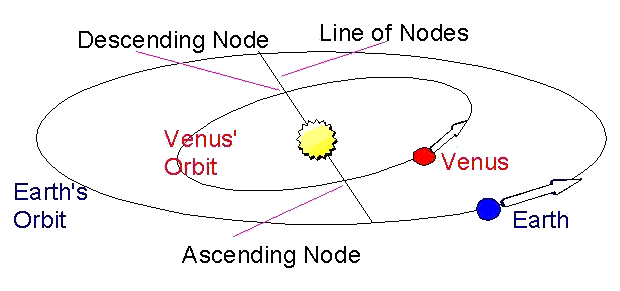
The following table gives the dates for past and future transits of Venus within a few hundred years of our present date. Dates and times are all referenced to Universal Time. Eastern Australian Standard Time is UT plus 10 hours. Western Australian Standard Time is UT plus 8 hours. Note that some transits go over the UT day boundary. In this case, the start time refers to the first date, and the end time refers to the second date.
| DATE(S) | Start (UT) | End (UT) |
| 7 Dec 1631 | 03:51 | 06:47 |
| 4 Dec 1639 | 14:56 | 21:54 |
| 6 Jun 1761 | 02:02 | 08:37 |
| 3-4 Jun 1769 | 19:15 | 01:35 |
| 9 Dec 1874 | 01:49 | 06:26 |
| 6 Dec 1882 | 13:57 | 20:25 |
| 8 Jun 2004 | 05:13 | 11:26 |
| 5-6 Jun 2012 | 22:09 | 04:49 |
| 10-11 Dec 2117 | 23:58 | 05:38 |
| 8 Dec 2125 | 13:14 | 18:48 |
| 11 Jun 2247 | 08:41 | 14:25 |
| 9 Jun 2255 | 00:50 | 07:50 |
There were no transits of Venus that occurred in the last (20th) century. And although it is possible for a person with good eyesight to view a Venusian transit (using a safe filter, but without a telescope), it is thought that the first transits ever to be observed were those of the 1600's. And in fact, the transits of 1761 and 1769 were the first to be predicted well in advance, and were thus the first to be generally observed by large numbers of people.
It was also in the 18th century that astronomers first realised that a transit of Venus offered a unique opportunity to measure the size of the solar system, and thus the distance of the Earth from the Sun. Up until that time, only the relative distances from the Earth to the Sun and to the other planets were known. These come from a measurement of orbital periods (which involve time measurement - something that could be done very accurately), and an application of the laws of planetary motion expounded by Kepler around 1610. However, not one absolute distance was known with any accuracy. And once one absolute distance was found, all the others could be easily computed.
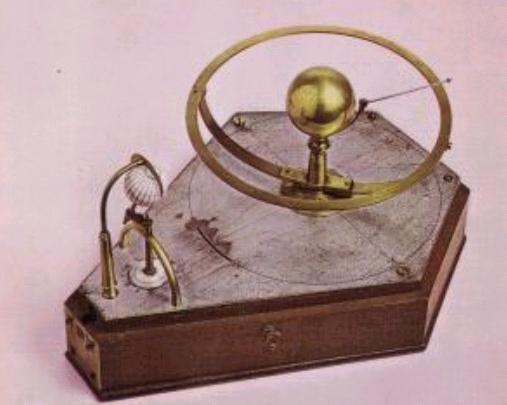
Nowadays, we obtain this distance to an accuracy of a few metres using radar techniques (bouncing radar pulses off Venus, and other solar system bodies), and this accuracy far exceeds anything we could calculate from transit measurements. The value of a Venus transit is now only of historical scientific interest.
However, to all Australians, a transit of Venus is of greater historical significance than to most other peoples. For it was to observe the 1769 transit of Venus that Captain James Cook was given orders from the British Admiralty to sail to the island of Tahiti in the south pacific ocean. Following transit measurements taken there, he was then instructed by secret sealed orders to proceed to investigate the Great South Land to the west. The Dutch and Portuguese had touched upon the western coast of this land at previous times, and had uniformly declared it unfit for human habitation. Cook, in exploring the eastern coast, found a land of much greater opportunity, and so it was that in 1770 he claimed the whole of the eastern part of what we now know to be Australia, and what he titled New South Wales (from Cape York to the south of the continent), for the British Crown. Were it not for the 1769 transit of Venus, the history of Australia would be very different from what it became in the years following this historic event. You and I would likely not be here, and our replacements might not be speaking English.
 |
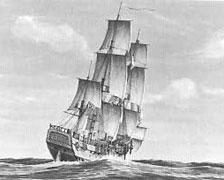 |
| Captain James Cook | Cook's ship Endeavor |
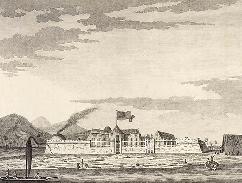 |
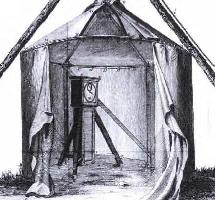 |
| Fort Venus on Tahiti | Cook's Observatory in Fort Venus |
There are many ways to observe the transit of Venus. However, you must be aware of basic safety precautions. NEVER LOOK DIRECTLY AT THE SUN AT ANY TIME. Looking directly at the Sun at any time is likely to result in permanent blindness. You should also never look at the Sun through binoculars or a telescope (or any optical instrument), unless an appropriate safe solar filter has been correctly installed.
Many web sites will carry near real time images of the Sun showing the progression of the transit. See the links section below for further information.
However, many people will want to view the transit themselves. The safest way to do this is through projection of the solar image onto a white screen. Although pinhole projection is very cheap and is useful for viewing eclipses, it is really worthless for viewing the transit of Venus (despite what some websites are saying). This is because pinhole projection of any practical size will not provide sufficient resolution for you to be able to even see the disc of Venus against the Sun.
| On June 8, 2004, the Sun will subtend an angle of 1890 arc seconds or 31.5 arc minutes to an observer on the Earth. This is just a little over half a degree. In contrast, Venus will only subtend an angle of about 58 seconds of arc. This is 1/32 or about 0.03 times the apparent diameter of the Sun. To observe Venus against the solar disc in projection, a small telescope (or a pair of binoculars) will be needed. Almost any small telescope will do - these are often available from department stores for $10 to $30. The setup is shown in the diagram below. A shade made out of cardboard or light plywood has a small hole cut in the centre, and the telescope or binoculars are affixed behind this hole. This is pointed toward the Sun and the focus of the telescope is adjusted so that a sharp image of the Sun is seen on the screen (white cardboard or white paper on plywood) placed at some distance behind the eyepiece. Adjust the distances between the telescope and screen so that an image of around 50 millimetres (or larger) in diameter is obtained. This will then provide sufficient resolution to see Venus move across the face of the Sun. You will find it a lot easier to handle if you mount the shade and screen on a framework so that they can be moved together to track the Sun as it moves across the sky. | 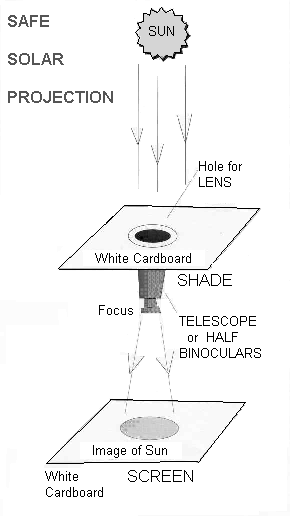
|
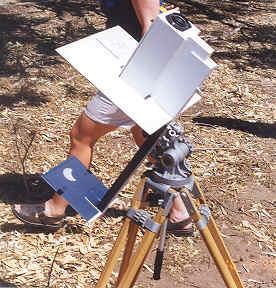
It is a very good idea to mount whatever filter you buy onto a mask which has sides that cover the top and sides of your face. This is particularly important if children are going to be using the device, as it makes it much less likely that anyone will be tempted to "take a peek" at the Sun without the filter. REMEMBER, IT IS YOUR RESPONSIBILITY TO MAKE YOUR EQUIPMENT SAFE FOR ALL WHO OBSERVE WITH IT. We can only give advice. Your eyesight, and the eyesight of your friends and family is very precious, and cannot be recovered once it is gone!!
The image below shows a mask mounted welding filter that is safe for solar viewing.
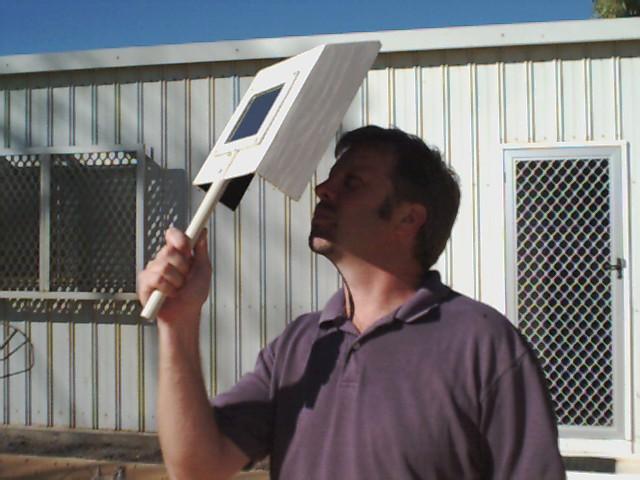
It is possible to conduct a simulation of the transit to evaluate whether or not you will be able to see Venus directly through a filter. Take a sheet of white cardboard and cut out a circle 300 millimetres in diameter, and paste this onto a large piece of dark cardboard. This disc will represent the Sun. Within this white disc draw a small circle only 9 mm in diameter and colour it dark black. Alternatively, cut off a 9 mm circle of black cardboard, and paste it onto the white disc. This small dark circle represents Venus. Place the dark cardboard with the white disc outside in the sunlight so that it stands nearly vertically. Stand at a distance of 33 metres from the disc. From this distance you are seeing the Sun and Venus as they will appear. More detail on this facet of the transit is discussed later.
It is also possible to photograph the event, although for a standard 35 mm camera, a 300 mm telephoto lens is about the smallest useful size to allow you to be able to see Venus. You also have the problem of pointing the camera without looking through the viewfinder. Use a slow speed film, a small aperture and a fast shutter speed. You need to experiment before the actual day of the transit. CCD cameras can also be used, but these should have an appropriate filter placed in front of the lens. You might like to try a welder's shade 14 filter as mentioned above for visual observations. We have used a small CCD video camera attached to a surplus 300mm telephoto lens and welder's filter to obtain good images of the Sun which may be displayed on a TV monitor. This provides safe viewing for many people.
WHAT TO LOOK OUT FOR
The most interesting times of a transit are probably the times around the start and end of the transit. Two main optical effects have been reported during previous transits of Venus.
One of these effects is due to the fact that Venus has a substantial atmosphere (and thus this effect is not seen during a Mercury transit, as Mercury has no atmosphere). This effect is seen when Venus is partially overlapping the Sun. The part of the planet that is not on the solar disc is seen to be surrounded by a ring of light. This is due to refraction of sunlight from behind and around the dark limb. This effect is called the radiant aureole effect.
The second effect is seen to occur just after second contact, and also just before third contact, when a small dark shape may be seen to appear connecting the disc of Venus with the solar limb. This shape may appear like a drop, and is know as the black drop effect. It is thought that this effect is mostly due to the Earth's atmosphere smearing or blurring the image. This effect makes it very difficult to time the transit accurately.
The total duration of the 2004 transit is 6.2 hours (although Australians will not see the end of the transit), and Venus will move very slowly across the face of the Sun. The motion will not immediately be apparent. Although there most probably will be some small sunspots visible on the Sun at the time of this transit, Venus is not likely to pass anywhere near them, as this transit occurs across a chord which is closer to the south pole of the Sun than it is to the solar disc centre. (Sunspots tend to occur in bands close to the solar equator.) The view may be more interesting in the light of H-alpha, as Venus may pass near a chromospheric feature such as a dark ribbon like filament. If it does pass near such features, its motion will be more apparent (because of the reference point this provides).
LINKS
There are many web sites that contain information on the transit of Venus. Here are some links that provide information before the event and images during the event: This web site <www.ips.gov.au> will provide updated images every 5 minutes from Learmonth Solar Observatory in Western Australia if clouds permit. There will be two image streams, one a white light image from the National Solar Observatory GONG site at Learmonth, and the other a hydrogen alpha image (which shows the solar chromosphere) taken with the main Observatory 25cm refractor. The GONG web site at the National Solar Observatory in Tucson will provide updated images from six GONG sites around the globe. The web site is at <gong.nso.edu/venus2004/>. The NASA web site at <sunearth.gsfc.nasa.gov/eclipse/transit/venus0412.html> provides much useful material on the transit, including times of the transit for many places around the world. Dr Udo Backhaus at the University of Essen has an excellent Venus transit site at <didaktik.physik.uni-essen.de/~backhaus/VenusProject.htm> for those people who want to learn how the transit may be used to measure the distance to the Sun.
VENUS TRANSIT SIMULATION
You can create your own simulation of the transit of Venus on 8 June 2004, prior to the event.
Print out the image below. This shows a simulated Sun against a black background, and within the solar disc is a small black circle, which represents the size of Venus as it will be seen against the Sun, during the actual transit. Measure the diameter of the simulated Sun on your printout and multiply this value by 109. The result is the distance from which you must view the image. For example, if the diameter of the Sun on the printed image is 14.5 cm, we multiply this by 109 which gives 1580 cm or 15.8 metres. This is close enough to 16 metres. Tape the printed image to a wall, and move back a distance of 16 metres. This then is how the Sun and Venus will appear to you looking through a SAFE solar filter. (DO NOT LOOK DIRECTLY AT THE SUN WITH THE UNPROTECTED EYE !!! ).
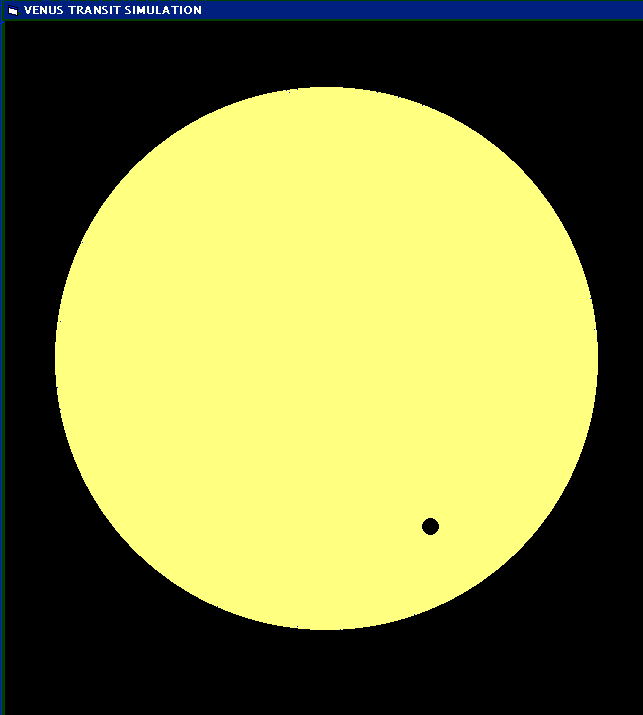
The information presented here was taken at the Learmonth Solar Observatory on North West Cape, Western Australia, and is presented courtesy of IPS Radio and Space Services, the Australian Space Weather Agency.
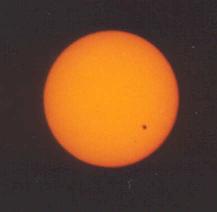 |
This image of the Sun showing the transit of Venus on June 8, 2004, was taken with a 35mm camera fitted with a 600mm telephoto lens. The disc of Venus, shown in silhouette against the solar surface has an angular diameter of just under one minute of arc, which is about 1/32 the apparent diameter of the Sun. A neutral density filter was used to reduce the Sun's light to acceptable levels. |
| This image is of a white light projection of the Sun. The black drop effect is due to turbulence in the Earth's atmosphere, and we found that it is only seen in wideband (unfiltered or white-light) views of the Sun. It was not seen in H-alpha (narrowband) imagery. | 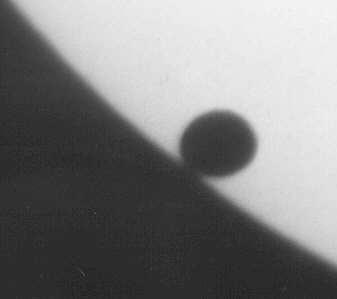 |
EQUIPMENT FOR RECORDING A VENUS TRANSIT
The diagram below shows a possible equipment setup for recording video and still images of a transit of Venus, as well as allowing for integrated light (full-disc) photometry.
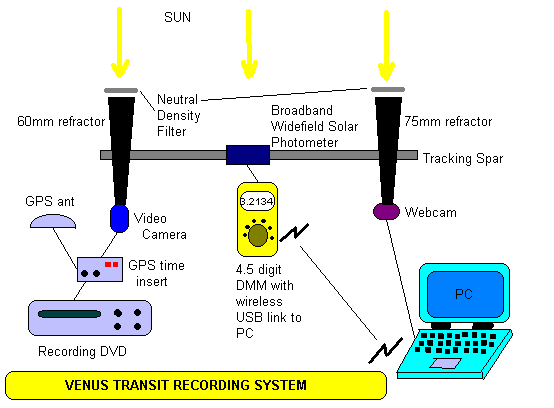
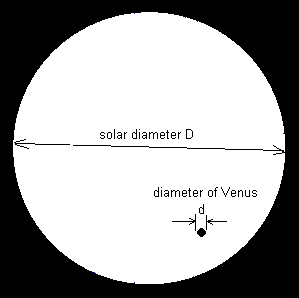 The ratio of the apparent Venusian to Solar diameters is d/D = 1/32.
The ratio of the apparent Venusian to Solar diameters is d/D = 1/32.
The reduction in luminosity δL due to the obscuration of a small part of the solar disc by Venus is given by:
δL / L = (d / D)2 = (1/32)2 = 0.00098
This is approximately 0.1%.
If the solar photometer output is approximately 3 V (and proportional to the incident solar flux) then a standard 4000 count digital multimeter is barely adequate to even hope to detect this small a fluctuation ( ie a maximum variation of 3 in the least significant digit (eg 3.102). A 40,000 count DMM would be more appropriate (eg 3.1023).
However, experience with wideband (whitelight) photometers at Learmonth Solar Observatory has shown that atmospheric transparency variations will exceed the 0.1% level. It is thus very unlikely that ground-based wideband solar photometry will detect the presence of Venus in transit across the Sun. Given this, it is inconceivable that any Venusian atmospheric effects will be detectable by such photometry.
Space-based 'Sun as a star' photometers (eg cavity radiometers aboard several spacecraft) should detect the transit, but whether they would record the 'radiant aureole' effect or any other Venusian atmospheric effect is debatable.
No comments:
Post a Comment